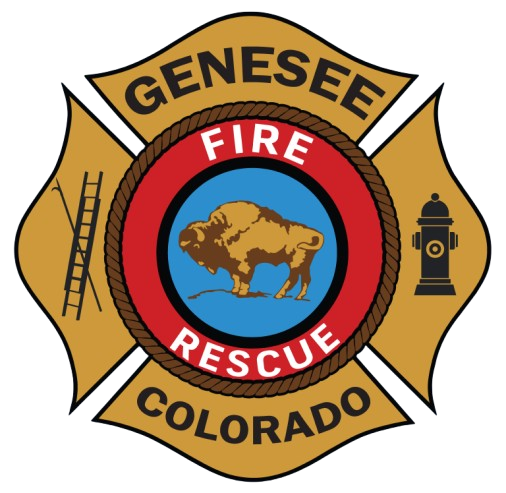Wildfire Risk Reduction
Genesee is located in the wildland-urban interface (WUI), by definition a high hazard fire environment. It is not a question of "if" wildfires will occur, but "when" they will occur. There are steps that can be taken before a wildfire occurs that improve the survivability of you and your home and that will help firefighters be able to defend your home from an approaching wildfire.
For more information, please expand and review the sections below.
Defensible space is the natural and landscaped area around a home or other structure that has been modified to reduce fire hazard. There are both initial and annual projects that will create and maintain defensible space and give firefighters the best chance of defending your home.
Here is a brief checklist that we recommend residents complete on an annual basis to improve defensible space:
- Clear roof, deck and gutters of pine needles and other debris.
- Mow grass and weeds to a height of 4 inches around your home.
- Rake all pine needles and other flammable debris away from the foundation of your home and deck.
- Dispose of slash from tree and shrub thinning.
- Remove trash and debris accumulations from your defensible space.
- Check exterior openings and vents to make sure they have covers (with opening of 1/8 of an inch or less) in place, free from debris and lint, and are in good condition.
- Store firewood pile at least 30 feet from all structures and ensure there is at least 10 feet of clearance between the pile and all trees.
- Remove dead vegetation from flowerpots and flower beds.
- Remove umbrellas, cushions, carpets, and other flammable items from the deck.
- Clear combustible materials from underneath the deck. This includes all plastic, live and dead vegetation, and wood.
- Check fire extinguishers to ensure they are not expired and are in good working condition.
- Schedule a routine heating system tune up.
- Check chimney screens to make sure they are in place and in good condition. If you burn wood, schedule a routine inspection and cleaning for your chimney system.
- Remove branches that overhang the roof and chimney.
Resources
The Home Ignition Zone: A guide to preparing your home for wildfire and creating a defensible space
Video about creating defensible space - (four minutes)
Studies show that firebrands and embers from wildfires, which can travel up to a mile from the wildfire front, ignite most structures, not the main fire front. There is a lot you can do to reduce the risk of a home ignition from embers and firebrands traveling in advance of the fire front. These little things and details can determine if your home survives a wildfire – or not.
Resources
- Overview
- Embers from an active wildfire can travel up to a mile from the wildfire front. Identify areas of vulnerability around your home and how you can protect your home from ignition due to embers
Videos
-
What you can do to reduce the risk that your house will ignite during a wildfire. - (13 min)
A scientific approach demonstrating the significance of little things can make a big difference - Minimizing the risk that embers will ignite a fire that destroys your home - (2 min)
Colorado-specific consumer advisory: Wildfire mitigation and insurance tips
Rocky Mountain Insurance Information Association information on wildfire
Tips from the Trenches: Does Your Safety Net have Holes? This 52-minute video from United Policyholders, a non-profit organization that is an insurance resource for consumers, reviews how to read your policy, including the fine print, and determine if your coverage is adequate. Historically in Colorado, as many of 50% of people who lost their homes in a wildfire found that they were underinsured.
Watch videos about actual wildfires in Colorado and elsewhere to learn how firefighters approach defending homes from wildfire, including the benefits of mitigation.
-
What might firefighters be thinking as they deal with a wildfire in Genesee. (19 min.)
Covers controlling wildfire versus protecting homes, size up of fire behavior, offense or defensive strategies, incident command system, developing an action plan, communications, structure triage and whether to abandon protecting a home. -
Fire Adapted Communities. (12 min.)
A Case Study from Colorado Springs and the Waldo Canyon Fire. Demonstrates the benefit of wildfire mitigation in a community. - Watch firefighters defending a home in the Black Forest fire in Colorado Springs (5 min.)
-
The Fire Line. Wildfires in Colorado. (27 min.)
Overview of risks in Colorado -
Fire in Paradise. (54 min)
Frontline episode documenting the timeline and issues associated with the Paradise Fire -
Are you and your home ready for wildfire, are you prepared to evacuate? (6 min)
Produced by CalFire but relevant to Coloradans, too - Conversation with Jack Cohen and the importance of home hardening
Wildfire Wednesdays 2020 webinar: Defensible Space and Home Hardening(opens in new window). Daniel Beveridge, Wildfire Mitigation Program Specialist, Colorado State Forest Service. (1 hour 13 minutes)
Wildfire Wednesdays 2020 Webinar: Fire Ecology and Behavior(opens in new window). Tony Cheng PhD, Professor, Department of Forest and Rangeland Stewardship at Colorado State University and Director, Colorado Forest Restoration Institute. (1 hour 12 minutes)
Sesame Street - Teaching Wildfire Safety
Sesame Street - https://sesameworkshop.org/resources/wildfires-color-learn/Wildfires: Color & Learn
